|
|
|
| My Favourite Planet > English > Middle East > Turkey > Pergamon > gallery 2 |
| Pergamon gallery 2 |
Pergamon art |
 |
 |
16 of 26 |
 |
 |
|
| |
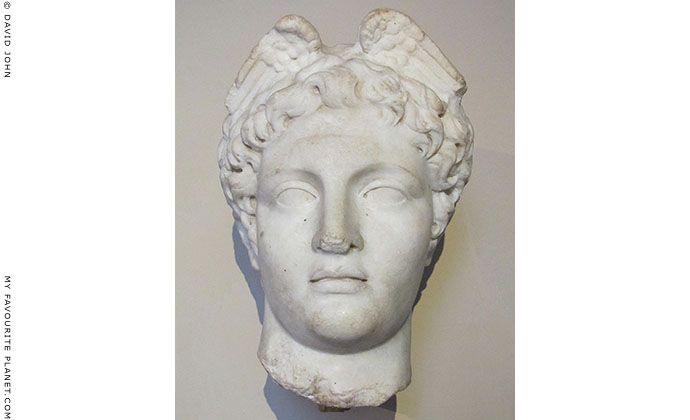
Marble winged head of Hermes, from Pergamon.
1st century AD. Istanbul Archaeological Museum. |
| |
This winged head of a youthful Hermes, made in the 1st century AD, during the period of Roman rule [1], is a copy of a type from the mid 5th century BC, probably after the Diskophoros (disc carrier), Doryphoros (spear carrier) or Herakles of Polykleitos the Elder of Argos. It is therefore often referred to as the "Hermes Diskophoros".
See also a very different representation of Hermes on the previous page.
In Greek myth Hermes (Greek, Ἑρμῆς; also Ἑρμείας, Hermeias; known to the Romans as Mercury), god of dexterity, messenger and guide, was the son of Zeus and the nymph Maia, daughter of Atlas and one of the Pleiades. He was born in a cave on Mount Kyllene (or Cyllene; Greek, Κυλλήνη), Arcadia, in the Peloponnese. He was the father of Pan and Hermaphroditus.
Shortly after his birth he is said to have killed a tortoise and used its shell to make the first lyre. He later gave the lyre to Apollo as compensation for cattle he had stolen from him (see more about Hermes, the tortoise and the lyre on Stageira gallery page 19). He was also credited with inventing language itself.
Apart from being inventive, a trickster and a thief, he was a swift messenger and errand boy of the gods, and is often shown with wings on his head, on a cap, petasos (πέτασος, a broad-brimmed sun hat) or helmet, or on his ankles or sandals (see illustrations below). His other symbol is the caduceus (Latin; known in Greek as κηρύκειον, kerukeion, herald's staff or wand), a wand entwined with two snakes, and sometimes with wings, which he used to induce sleep and healing.
He was the second youngest of the Olympian gods, which may account for the fact that the elder deities were always sending him on errands. He is often portrayed as a protector of his younger half-brother Dionysos.
Hermes was given several epithets, and there were so many stories about or involving him, and so many statues and herms of him on roads, at markets and gymnasiums, outside houses and other buildings, that it seems obvious that he was a very popular deity for all classes of people. However he was not worshipped or honoured with temples in the same grand style as other gods such as Zeus, Apollo, Athena or Artemis; sanctuaries of Hermes were usually quite modest.
Like many of the Greek gods, he was endowed with numerous skills, attributes and responsibilities as patron of various human professions and activities, including trade, thievery and travel - in this world and the next, as he also guided the dead to the underworld (as Hermes Psychopompos, Ἑρμῆς Ψυχοπομπός, Guide of Souls, see image below). Thus he was associated with death as well as sleep and dreams.
Hermes' association with markets and commerce may have developed from his more ancient role as the master of animals, wild and domesticated, a herdsman and tender of horses and mules. According to Hesiod, he also regulated the number of animals owned by farmers; animals and their products were among the most important indicators of wealth and purchasing power, especially before the introduction of coinage.
His multi-skilled and multi-tasking existence leads one to think that he was a composite or replacement for various earlier pre-Olympian and local deities. His attributes and responsibilities also overlapped with those of other deities, for example Hypnos (Ὕπνος, Sleep) and his brother Thanatos (Θάνατος, Death) who are also depicted with wings on their heads, as well as Morpheus (Μορφεύς) the god of dreams.
The winged head of Hermes from Pergamon and similar statues portray the god as young, clean-shaven and athletic. However, this head and the smaller version in Izmir (see photo, above right) show him as well-fed, even chubby (puppy fat?), and not quite the lean, mean Olympic machine. Perhaps the Pergamese preferred their god of merchants and shop-keepers to carry a bit of fat as a sign of prosperity.
See also:
More photos and infromation about Hermes on
the Hermes page of the MFP People section.
A relief of Hermes with his caduceus on a column drum from the Temple of Artemis at Ephesus, on Selcuk gallery 1, page 2.
Reliefs of Hermes on Kuretes Street, at the Ephesus
archaeological site, on Ephesus gallery 1, page 9. |
|
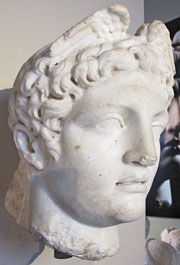
The winged head of Hermes.
Istanbul Archaeological
Museum. |
| |
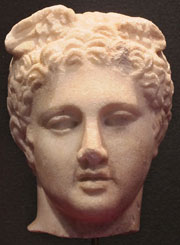
A small marble winged head
of Hermes. Roman period. [2]
Izmir Archaeological Museum. |
| |
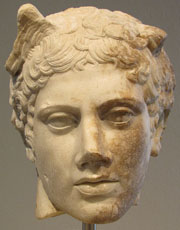
Head of "Polykletian
Diskophoros". Roman marble
copy, circa 140 AD, of a bronze
statue by Polykleitos of Argos
around 460 BC. The wings were
added by the Roman copyist.
Height 24.8 cm. It has been
estimated that the statue
to which it belonged was
175-177 cm tall.
Altes Museum, Berlin.
Inv. No. Sk 1833. |
| |
| |
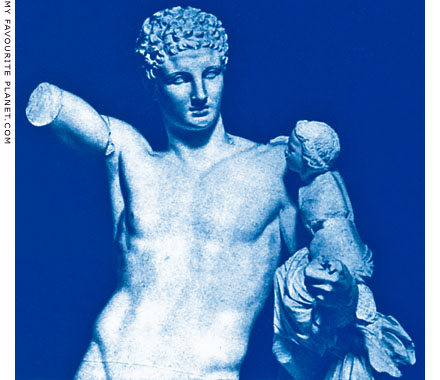
Upper part of Hermes with the infant Dionysos by Praxiteles.
Olympia Archaeological Museum, Greece.
Image source: Emanuel Loewy, The rendering of nature
in early Greek art. Duckworth, London, 1907. |
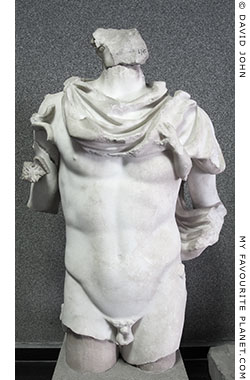
Torso of a statue of Hermes
carrying the infant Dionysos.
From the Pergamon Asklepieion.
Marble, Roman period.
Bergama Archaeological Museum. |
|
| |
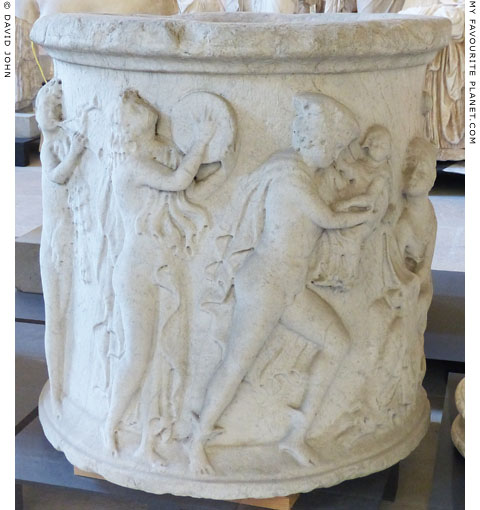
Late Hellenistic relief on a marble puteal (well-head; Greek, περιστόμιον, peristomion)
showing Hermes carrying the infant Dionysos, followed by a dancing maenad playing
a tympanon and a satyr playing a double flute (aulos). In front of Hermes a seated
nymph waits to receive the infant, and holds out a cloth to cover him.
The scene is similar to other extant reliefs, particularly a puteal in the Vatican Museums,
Rome, dated to the 4-3rd century BC.
Skulpturensammlung, Albertinum, Dresden. Inv. No. ZV 4125. |
| |
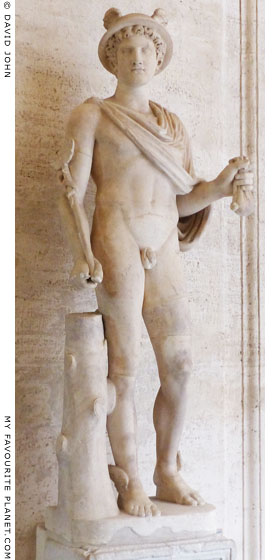
Marble statue of Mercury/Hermes,
with winged ankles, wearing a winged
helmet and short cloak, and carrying a
caduceus and a purse. Roman copy of
an early 4th century BC Greek original.
Palazzo Nuovo,
Capitoline Museums, Rome.
Inv. No. MC 60. |
|
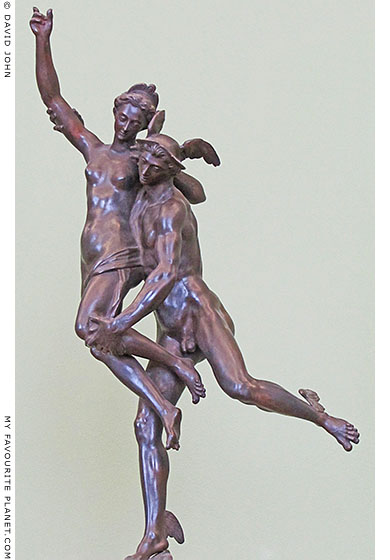
Bronze statuette of Mercury and Psyche.
Northern Alpine region, early 17th century AD.
Bode Museum, Berlin. Inv. No. 7980. |
|
| |
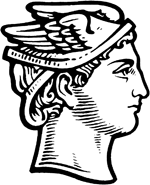
Winged head of Hermes
used as the logo of the
Greek postal service ELTA. |
|
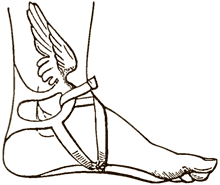
A winged sandal of Hermes/Mercury from a bronze statue from Herculaneum, now in the National Archaeological Museum, Naples.
Talaria (Latin, talaris, of the ankle) were the small wings on the
ankles of the god, often shown in ancient art as one of his
attributes. Sometimes the talaria are seen growing directly
from his ankles or his sandals.
Source: William Smith, A Dictionary of Greek and Roman Antiquities. Harper, New York, 1878. At archive.org.
See photos of the statue and the sandal on
the Hermes page of the MFP People section. |
|
| |
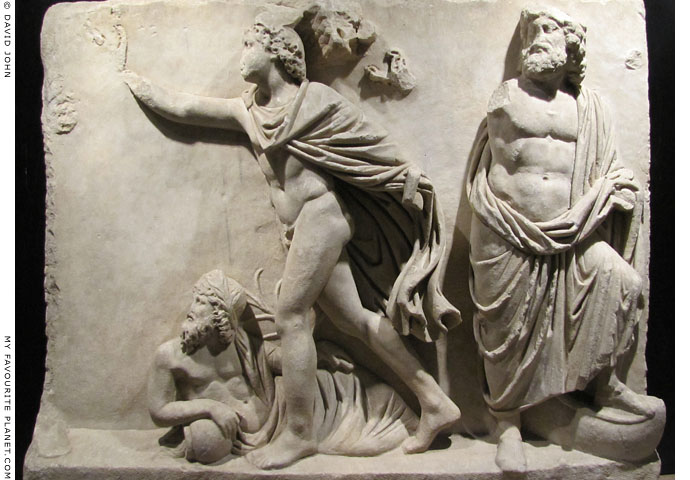
Marble relief of the gods Okeanos (god of the rivers), Hermes and Poseidon.
From Nikomedia (Izmit), Turkey. Roman Imperial period, 2nd century AD.
Istanbul Archaeological Museum. Inv. No. 5344 T. |
| |
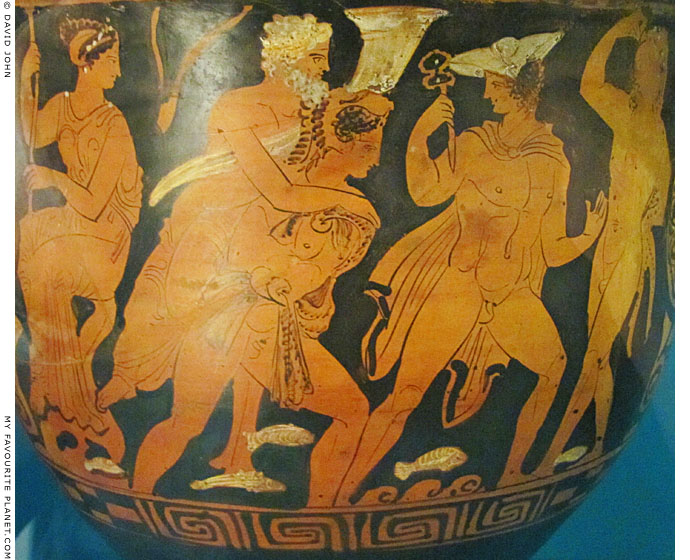
Hermes in a scene from the underworld. Hermes, as Hermes Psychopompos (Ἑρμῆς Ψυχοπομπός),
guide of souls, leads Herakles, who is carrying a bearded male with a cornucopia, probably Hades,
god of the underworld, through the River Styx. He wears a petasos (πέτασος, a broad-brimmed
sun hat, originally from Thessaly) and a chlamys (χλαμύς) cloak, and carries a caduceus
(Latin; known in Greek as κηρύκειον, kerykeion, herald's staff or wand) in his right hand.
Detail of an Attic red-figure bell krater, circa 370 BC.
Berlin, Antikensammlung SMB. Inv. No. 31094. |
| |
winged head
of Hermes
from Pergamon |
Notes, references and links |
 |
|
1. Winged head of Hermes in Istanbul.
Marble. Height 29 cm.
Found at the Sanctuary of Demeter, Pergamon, in 1909.
Istanbul Archaeological Museum.
Inv. No. 2162 T. Cat. Mendel 555.
See:
H. Hepding, Athenische Mitteilungen, XXXV, 1910, page 499 ; plate XXIV, 1.
Gustave Mendel (1873-1938), Catalogue des sculptures grecques, romaines et byzantines,
Tome Second, pages 279-280. Musée Impérial, Constantinopole (Istanbul), 1914.
2. Small winged head of Hermes in Izmir.
Probably from a statuette. As with many of the exhibits in the excellent Izmir Archaeological Museum, the label for this head, in Turkish and English, does not mention the place in which it was found, or state the inventory number. |
|
|
Maps, photos and articles: © David John,
except where otherwise specified.
Additional photos: © Konstanze Gundudis
All photos and articles are copyright protected.
Images and materials by other authors
have been attributed where applicable.
Please do not use these photos or articles without permission.
If you are interested in using any of the photos for your website,
project or publication, please get in contact.
Higher resolution versions are available on request. |
| |
 |
Visit the My Favourite Planet Group on Facebook.
Join the group, write a message or comment,
post photos and videos, start a discussion... |
|
|
| |
|
|
|